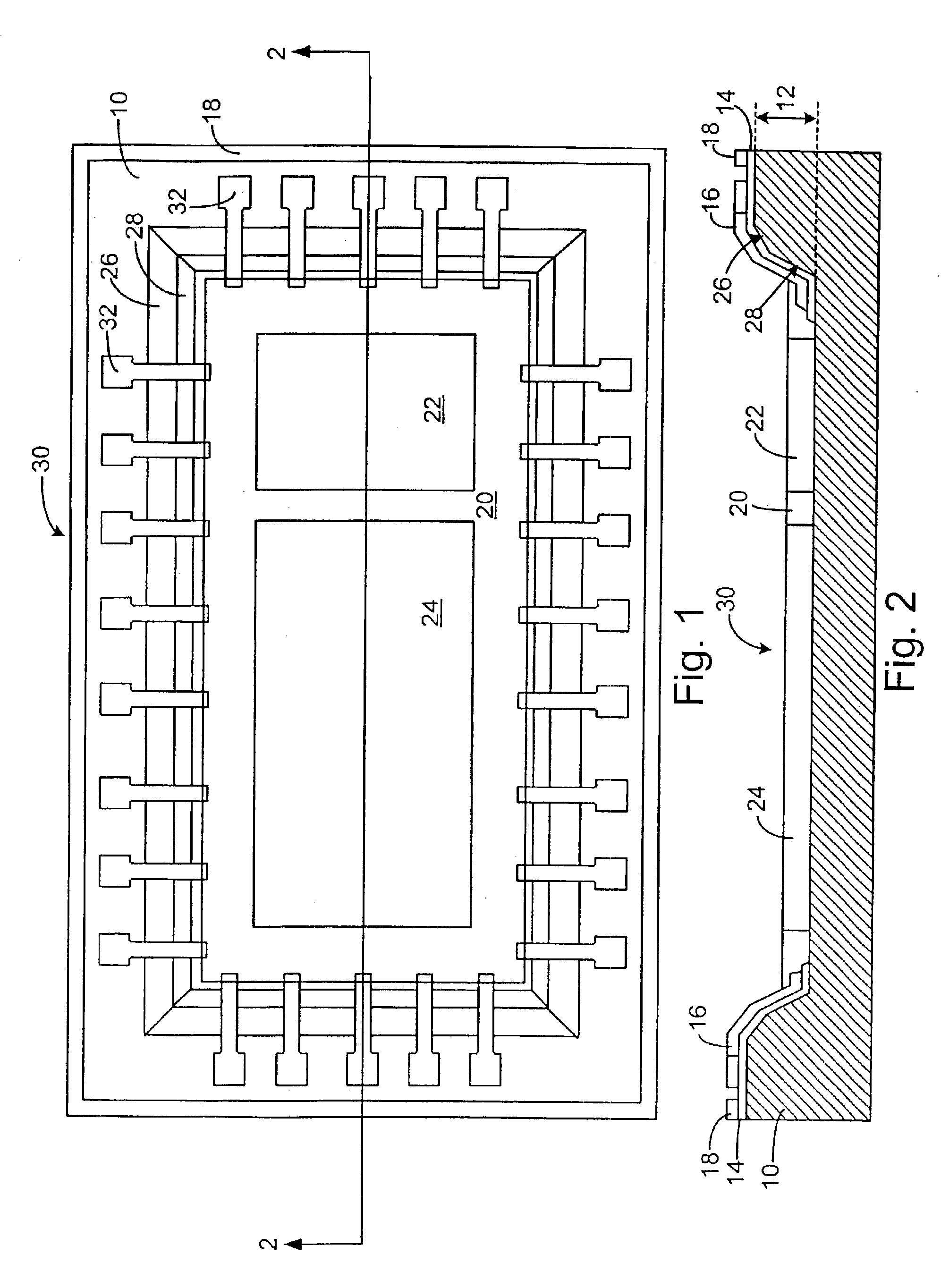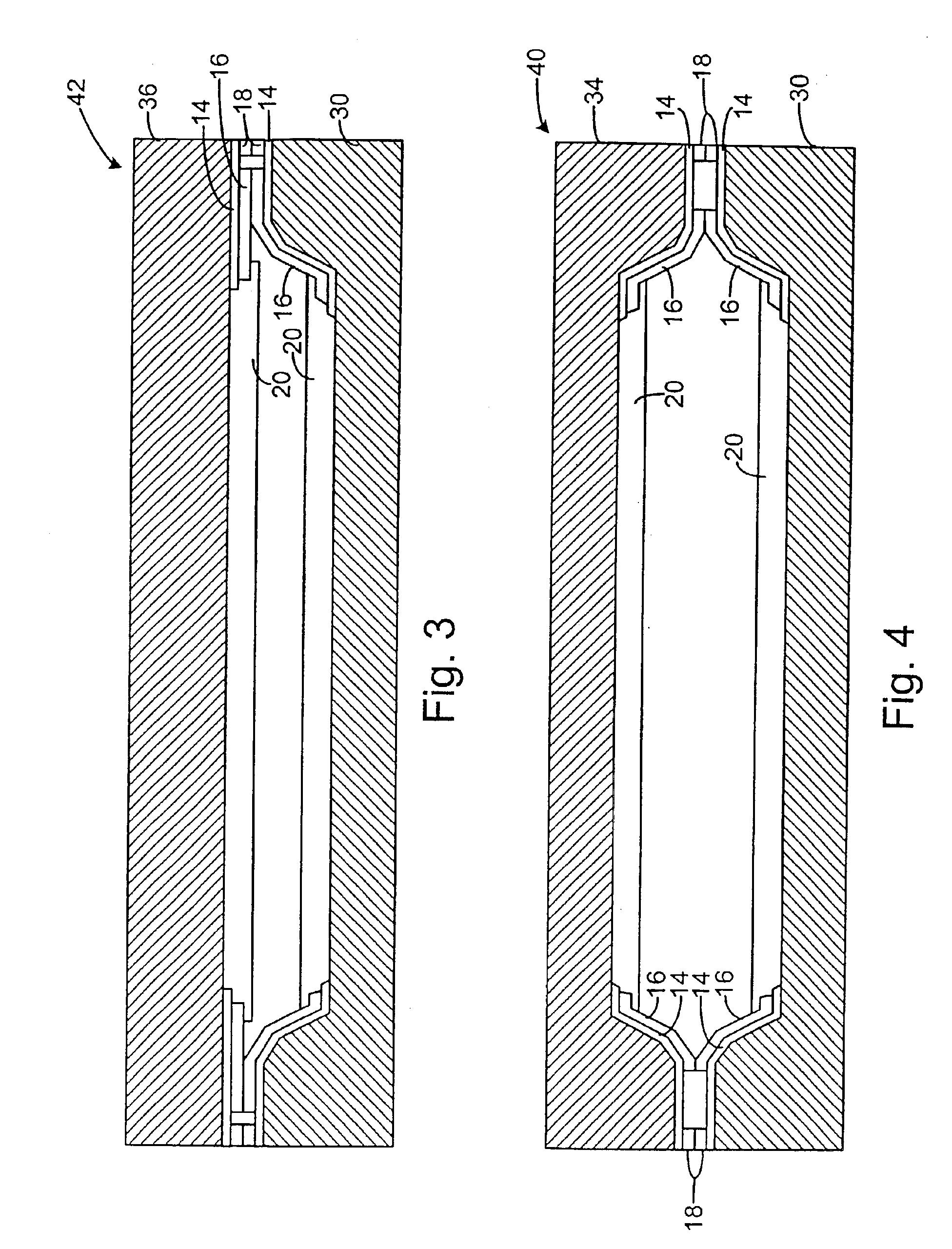Multi-level integrated circuit for wide-gap substrate bonding
a technology of integrated circuits and substrates, applied in the direction of fluid speed measurement, instruments, coatings, etc., can solve the problems of large gaps between substrates, limited gap spacing using conventional processes, and inability to deposit the large thickness required for some applications,
- Summary
- Abstract
- Description
- Claims
- Application Information
AI Technical Summary
Benefits of technology
Problems solved by technology
Method used
Image
Examples
exemplary embodiment 42
[0032]FIG. 3 is a first exemplary embodiment 42 of a micro-machined system using a multi-level integrated circuit embodied using the invention. In this embodiment, a first IC 30 has been etched to remove a portion of the substrate material and then processed with semiconductor thin-film layers 20 to create circuit elements. The circuit elements on the etched surface of IC 30 are coupled to the non-etched surface using conductive layer 16 as an interlevel conductor 32 (see FIG. 1). The conductive layer 16 is isolated from the substrate using a dielectric layer 14. The first IC 30 is shown bonded to a conventional substrate, second IC 36. The second IC 36 preferably also has been processed with semiconductor thin-film layers 20 to create circuit elements. These circuit elements are also connected with a conductive layer 16 to align with the conductive layer 16 of first IC 30. A seal 18 is shown here to provide preferably, but optionally, a hermetic seal around the peripheral edge of t...
exemplary embodiment 44
[0035]FIG. 5 is a third exemplary embodiment 44 of a micro-machined system with two multi-level integrated circuits embodied using the invention. In this embodiment, a fourth IC 38, having a surface area smaller than the surface area of first IC 30, is bonded to first IC 30 using an alternative seal 52 that is also preferably an adhesive. Optionally, the seal 18 of the earlier embodiments could be used in place of or in conjunction with alternative seal 52. The alternative seal 52 preferably provides a hermetic seal and is preferably applied after the first IC 30 and the fourth IC 38 are bonded together or optionally applied during the bonding process. In this embodiment, another feature is that conductive layer 16 on first IC 30 can extend to beyond the peripheral edge of fourth IC 38 to allow for connection to external circuits such as with wire bonding or other conventional connection techniques.
exemplary embodiment 46
[0036]FIG. 6 is a fourth exemplary embodiment 46 of a micro-machined system using a multi-level integrated circuit embodied by the invention to form a pressure sensor. In this embodiment, the thin-film layers 20 of single etched substrate 50 contain a first pressure sensor 53, preferably a doped polysilicon layer. Also the thin-film layers 20 of non-etched substrate 54 contain a second pressure sensor 51, preferably a doped polysilicon layer. The doped polysilicon layers have a resistance that varies in proportion to the flex force applied to the layer. For the non-etched substrate a first pressure 55 is applied to the external surface of the substrate causing the substrate and accordingly the second pressure sensor 51 to flex thereby changing its resistance. The single etched substrate 50 has a second pressure 57 applied to its external surface that causes the single etched substrate and accordingly the first pressure sensor 53 to flex thereby changing its resistance. By providing ...
PUM
| Property | Measurement | Unit |
|---|---|---|
| depth | aaaaa | aaaaa |
| depth | aaaaa | aaaaa |
| depth | aaaaa | aaaaa |
Abstract
Description
Claims
Application Information
 Login to View More
Login to View More - R&D
- Intellectual Property
- Life Sciences
- Materials
- Tech Scout
- Unparalleled Data Quality
- Higher Quality Content
- 60% Fewer Hallucinations
Browse by: Latest US Patents, China's latest patents, Technical Efficacy Thesaurus, Application Domain, Technology Topic, Popular Technical Reports.
© 2025 PatSnap. All rights reserved.Legal|Privacy policy|Modern Slavery Act Transparency Statement|Sitemap|About US| Contact US: help@patsnap.com



